Order these records by:
Browse Collection › LC Subject Heading › 17 records found where LC Subject Heading is Real property -- North Carolina -- Durham -- Maps | ||
 | Gray's new map of Durham, 1881 This cadastral map from 1881 depicts buildings, street names, businesses, property owners, and railroads in Durham, North Carolina. Scale 350 feet = 1 inch or [ca. 1:4,200]. | |
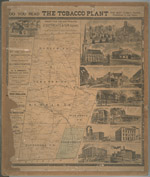 | Map of Durham County, N.C. This 1887 map indicates the location of landowners, churches, quarries, saw mills, creeks, railroads and a coal mine. Includes advertisements for local businesses including the newspaper Tobacco Plant, Seeman Printery, Vaughn & Tenny, druggists and fourteen illustrations of: Morris & Son factory, J.S. Carr’s residence, E.J. Parrish’s residence, Trinity Church, Banner Ware-house, View of Main Street, View of Mangum Street, Durham Hotel (Claiborn), E. Morehead & Co. bankers, Globe warehouse, Durham Cotton mills, Z.I. Lyon & Co.’s tobacco factory, Blackwell’s Co-operative tobacco factory, and W. Duke Sons & Co.’s factory. The map provides the names and boundaries of six Durham County townships including Mangum, Lebanon, Durham, Patterson, Oak Grove, and Cedar Fork. Scale [ca. 1:63,360]. | |
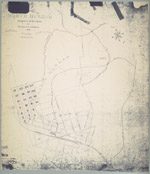 | Map of the town of North Durham: property of B. L. Duke and its relative position to Durham, North Carolina An 1890 map showing the property owned by Brodie Leonidas Duke in Durham, North Carolina, just east of Trinity College, in an area now identified as Trinity Park. The map also provides names of downtown streets, shows the location of Bobbin & Shuttle Mills, fertilizer factory, cotton factory and railroad lines. Scale 400 feet to 1 inch or [ca.1:4800]. | |
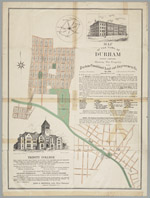 | Map of the town of Durham, North Carolina:showing the property of the Durham Consolidated Land and Improvement Company This 1890 map published by the Durham Consolidated Land & Improvement Company indicates its property holdings north and west of Trinity College, Durham, North Carolina, in areas now known as Trinity Heights, Walltown, and Old West Durham. Contains an advertisement with illustration promoting Trinity College as well as a letter by Richard H. Wright, secretary of the Company, extolling the virtues of Durham's business climate. In 1890, the Durham Consolidated Land & Improvement Company published this map to indicate its property holdings north and west of Trinity College in an area now known as Trinity Heights, Walltown, and Old West Durham. The map also provides some information about streets near the Blackwell Tobacco Factory, now Downtown Durham. It also features an advertisement promoting Trinity College as well as the virtues of Durham's business climate. | |
 | Bird's-Eye View of the City of Durham, North Carolina, 1891 This 1891 map shows an aerial view of Durham and provides an extensive index to the location of tobacco warehouses, factories, restaurants, groceries, dry goods dealers, churches, and residences located in Durham. Business owners include: Robert I. Rogers, Richard B. Fitzgerald, W. Shelburn, photographer, Q. E. Rawls, dry goods and many others. Also mentioned are the editors of the local newspapers E.C. Hackney of the Durham Recorder, Al Fairweather of the Durham Daily Globe, and J.A. Robinson of the Durham Daily Sun. | |
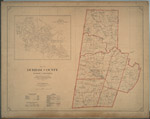 | Map of Durham County, North Carolina prepared by the direction of the County Commissioners from actual surveys This 1920 map provides two views of Durham County. One view delineates the school districts in Durham County and indicates which schools served white or black pupils. It also identifies Mangum, Lebanon, Durham, Oak Grove, Carr, Patterson, and Cedar Fork townships and provides locations for cemeteries and roads. Another view labelled Cities of East and West Durham identifies street names for areas that are now customarily referred to as Old West Durham, including the Ninth Street business district, Trinity Park, Trinity Heights, Walltown (portion), Duke University (East Campus), Old North Durham, Downtown Durham and Fayetteville Street (Hayti), West End, Morehead Hill (portion), Edgemont and Morning Glory, Cleveland-Holloway Street, East End, East Durham (portion). | |
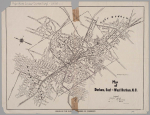 | Map of Durham, East and West Durham, N.C. A 1924 Durham Chamber of Commerce map depicting schools, mills, factories, and cemeteries in Durham. This map contains information pertaining to neighborhoods now commonly referred to as: West End, Lyon Park, West Durham (area surrounding Erwin Mills), Pearl Cotton Mills Village, Duke University (East Campus), Trinity Heights, Walltown, Trinity Park, Old North Durham, Morehead Hill, Duke Park, Downtown Durham (Central Business District), Cleveland-Holloway Street, East End, East Durham (portion), Edgemont and Morning Glory near the Golden Belt Manufacturing Company, Hayti. The map identifies street names and the location of hydrants, fire alarm boxes and fire stations. | |
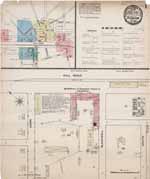 | Sanborn Fire Insurance Map, Durham, North Carolina, 1884 This five-page fire insurance map by the Sanborn Map & Publishing Company provides a detailed look at the commercial buildings that stood at the center of Durham, North Carolina in 1884. The map contains an index page to city streets that identifies the location of churches, tobacco warehouses, and other enterprises. A key to the maps provides details about the construction of the buildings (whether they have been built from stone, brick or wood) as well as details about the number of stories and windows. The maps also list the type of retail enterprises housed in various structures. For larger businesses, the cartographer details the number of workers employed and describes the establishments’ fire-fighting capabilities. Scale ca. 1" = 50 feet or [ca. 1:600]. A georeferenced version of this map is also available on the Digital Durham website. | |
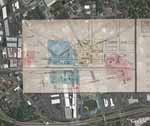 | Sanborn Fire Insurance Map, Durham, North Carolina, 1884 (Google Earth Overlay) Beta Using the Google Earth web application, we have created semi-transparent images from the original set of Fire Insurance Map of 1888 and placed these over satellite imagery of present-day Durham. Because of a paucity of information of some buildings presented on pages 6 and 7, we provide an approximate location for the Bobbin and Shuttle Mill, the Durham Cotton Manufacturing Company, and J.W. Allen's Tobacco Prize House. This fire insurance map by the Sanborn Map & Publishing Company provides a detailed look at the commercial buildings that stood within the town limits of Durham, North Carolina in 1884. The map contains an index page to city streets and the location of the county courthouse, jail, churches, manufacturers, tobacco warehouses and prizing establishments, mills, stables, and other enterprises. A key to the maps provides details about the construction of the buildings (whether they have been built from stone, brick or wood) as well as details about the number of stories a... | |
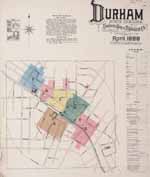 | Sanborn Fire Insurance Map, Durham, North Carolina, 1888 This fire insurance map by the Sanborn Map & Publishing Company provides a detailed look at the commercial buildings that stood within the town limits of Durham, North Carolina in 1888. The map contains an index page to city streets and the location of the county courthouse, jail, churches, manufacturers, tobacco warehouses and prizing establishments, mills, stables, and other enterprises. The map's legend provides details about the construction of the buildings (whether they have been built from stone, brick or wood) as well as details about the number of stories and windows. The map also lists the type of commercial enterprises housed in various structures. For larger businesses, the cartographer details the number of workers employed and describes the establishments’ fire-fighting capabilities. Scale ca. 1" = 50 feet. A georeferenced version of this map is also available on the Digital Durham website. | |
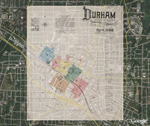 | Sanborn Fire Insurance Map, Durham, North Carolina, 1888 (Google Earth Overlay) Beta Using the Google Earth web application, we have created semi-transparent images from the original set of Fire Insurance Map of 1888 and placed these over satellite imagery of present-day Durham. Because of a paucity of information of some buildings presented on pages 6 and 7, we provide an approximate location for the Bobbin and Shuttle Mill, the Durham Cotton Manufacturing Company, and J.W. Allen's Tobacco Prize House. | |
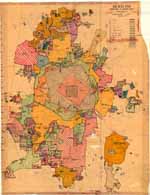 | Durham, North Carolina: Annexation Map The base of this annotated street map was first produced by the Department of Transportation and Utilities, Durham, N.C. in 1979. From the 1980s to 2001, two employees of Durham's Department of Public Works developed this annexation map to illustrate the City of Durham's growth from 1890 to 2001. Pen and ink notations demarcate where the city limits stood in 1890, 1901, 1925, 1957, 1960, and 1966. A color legend indicates when the city added parcels of land between 1970 and 2000. The map provides information the size of parcels, name of developer or development and date of annexation. The map was developed by Lee Ribet and later updated by Tina Raneri, both employees of the Department of Transportation and Utilities, later known as the Department of Public Works. Scale 1 inch = 1600 feet or [ca. 1:19,200]. | |
 | Map of Forest Hills/ Durham, N.C. Owned by New Hope Realty Co. This map drawn by E.H. Copley in 1927 provides a detailed rendering of individual lots owned by the New Hope Realty Company in Forest Hills, Durham, N.C. and their measurements as they were recorded in plot book 6 at the Registrar of Deeds office. The map also provides names of streets. Scale 1" = 100 feet. | |
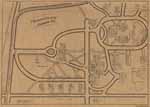 | Trinity College/Durham, N.C. W.P. Budd's map of the Trinity College, Durham, North Carolina identifies key structures and indicates where they stood on campus in 1902. The map includes the location of the chapel, library, dormitories, recreational areas, and stables as well as the homes of professors John Spender Bassett, William I. Cranford, Edwin Mims, William H. Pegram, A. H. Merritt, M. J. Edwards, Robert L. Flowers, and President John C. Kilgo. Additionally, the map shows the location of Watts Hospital and Trinity Park School as well as railroad and streetcar lines. Some of the homes illustrated on this map were later moved to the eastern side of Buchanan Avenue, in the Trinity Park neighborhood. | |
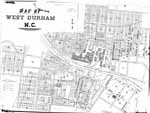 | Map of West Durham, N.C. Civil engineer C.M. Miller drew this detailed map of West Durham, North Carolina in 1910. He identifies street names for an area which is today largely associated with the Old West Durham neighborhood, Erwin Road and Duke's Central campus. The map identifies structures at the Erwin Mills and the size of homes owned by the textile company. It also indicates the location of churches and schools and identifies the names of some property owners. Scale 150 feet to the inch or [ca. 1:1800]. | |
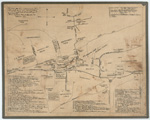 | "This Map of Durham as I remember in 1867-1868. Drawn from memory entirely and no attempt made at correct angles or measurements." Lewis Blount of Abbeville, South Carolina penned this map in 1923. He called it, "This Map of Durham as I remember in 1867-1868. Drawn from memory entirely and no attempt made at correct angles or measurements." He delineates some of the natural features--creeks and springs--major roads, the North Carolina railroad line running through town, of what is now downtown Durham and southwest Durham. He also provides an index to some sixty sites including graveyards, homesteads, churches, black- and white-owned businesses and factories. | |
 | Occupancy map, business section Durham, North Carolina This 1972 map created by the Allenton Realty and Insurance Company identifies the types of businesses that occupied commercial space in the central business district of Durham, North Carolina. Th map highlights a geographic area that includes "Five Points" and is bounded by Peabody Street, Roxboro Road, Morgan Street and the "West Loop." Scale [ca. 1:1,150] | |
digitaldurham@duke.edu · About this site · Copyright © 2001 - 2006. Trudi J. Abel. All Rights Reserved.
The copyright interest in the material in this digital collection has not been transferred to the Digital Durham project. These text and images may not be used for any commercial purpose without the permission of the David M. Rubenstein Rare Book & Manuscript Library and the Digital Durham Project. Copyright permission for subsequent uses is the responsibility of the user.
